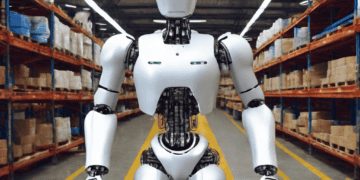Supply chains have become pivotal players in the modern business landscape, facilitating the efficient movement of products and services from manufacturers to end consumers. However, the intricacies of global supply chains, coupled with rising customer expectations and market dynamics, have posed considerable challenges for businesses. Historically, supply chain management heavily relied on manual processes and rule-based systems. As a response to the growing volume and value of data, many companies have turned to artificial intelligence (AI) to revolutionize their supply chain operations. This article explores two significant applications of AI in the supply chain: network strategy and demand-supply matching.
Supply Chain Network Strategy
Network strategy involves designing and planning a company’s supply chain network, including the physical infrastructure, distribution channels, product flow, and relationships with suppliers and customers. Its goal is to create a network that aligns with the organization’s business objectives. This section outlines the evolution of network strategy over the past few decades.
Traditionally, network strategy decisions were made through collaboration between operations, finance, and strategy teams, often relying on intuition rather than rigorous analysis. This approach lacked the ability to comprehensively balance conflicting objectives, such as maximizing profit, minimizing transit time, reducing carbon emissions, and enhancing customer experience.
Today, AI and optimization play a crucial role in network design. AI-driven technology ingests vast amounts of data and considers real-world constraints, facilitating an accelerated model-building process. This technology allows for the comparison of existing networks with desired ones and offers step-wise guidance for achieving these goals. It integrates operational and financial data from global supply chains, aiding in globally optimized decision-making. Additionally, it streamlines procurement decisions, which is particularly valuable for organizations undergoing mergers.
In an era where supply chains must prepare for disruptions rather than react to them, scenario modeling has become essential. This ensures continuity and resilience within the supply chain, enabling companies to respond effectively to challenges and optimize the flow of products while minimizing their carbon footprint.
A noteworthy development on the horizon is the integration of AI, particularly Gen AI, which will automate scenario generation and provide relevant alerts to key stakeholders, enhancing the outcomes of network design.
Zoe Kokje Schouten, business director of supply chain solutions at AIMMS, notes, “Supply chains of the future will need to adapt strategically and tactically for business continuity. AI will play a central role in analyzing threats and notifying key stakeholders in real-time, adding significant value to how companies run Network Design scenarios.”
Demand-Supply Matching
Demand forecasting comes with its own set of challenges, including incorporating complex business rules, managing large amounts of diverse data, and addressing demand variability and uncertainty.
AI-powered demand planning addresses these challenges effectively. It can handle complex business rules efficiently and adapts in real time. Machine learning algorithms learn patterns from extensive data and automate the extraction of business rules from contracts and reports. Data from various processes influencing demand planning can be ingested, integrated, and interpreted by intelligent workflows, ensuring trustworthy forecasts. Effective demand planning combines forecast precision with human judgment, resulting in data-driven insights and strategic decisions.
AI-driven demand planning also enables businesses to manage demand variability and uncertainty through scenario planning and risk assessment tools. Leveraging AI algorithms, these capabilities simulate multiple scenarios, providing valuable insights into inventory requirements under different circumstances. Demand collaboration platforms foster interdepartmental collaboration, providing real-time access to demand forecasts, inventory data, and market insights.
Embracing these capabilities allows businesses to optimize inventory levels, minimize carrying costs, prevent stockouts, and ultimately enhance customer satisfaction in today’s dynamic business landscape.
Raul Jurado, director of customer success at Asper.ai, emphasizes the transformative power of AI-led forecasting solutions: “AI-led forecasting solutions have been a game-changer for my clients, driving remarkable cost savings and increased efficiency. Embracing best-in-class technology has positioned them as industry leaders, unlocking a world of data-driven possibilities for growth and profitability.”
In conclusion, AI is revolutionizing supply chain operations, offering opportunities for strategic advancements in network strategy and demand-supply matching, ultimately enhancing the efficiency and resilience of modern supply chains.
Your source for supply chain report news updates: The Supply Chain Report. For international trade insights and tools, head to ADAMftd.com.
#SupplyChainAI #NetworkStrategy #DemandSupplyMatching #AIinSupplyChain #SupplyChainOptimization #AIforBusiness #SupplyChainResilience #AIandDemandForecasting #AIforBusinessContinuity #GenAI #SupplyChainManagement #AIinLogistics #SmartSupplyChain #AIinBusiness #MachineLearninginSupplyChain #SupplyChainInnovation #IntelligentSupplyChain #DataDrivenForecasting #SupplyChainSolutions

















